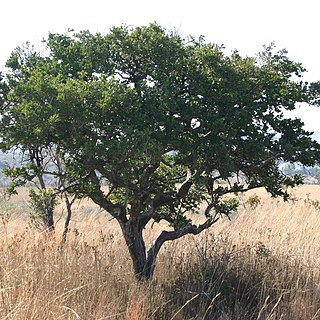Shrub or slender much-branched small tree, 3–8 m. high, with a ± dense stiff growth, glabrous except for the inflorescence; branches unarmed, with rough grey or brown bark, often longitudinally split or corky; young branchlets usually pale brown, conspicuously lenticellate.. Leaves subsessile, coriaceous, rigid, narrowly oblong-lanceolate, elliptic or obovate, 4–8 cm. long, 1–4 cm. wide, acute or subacute and conspicuously pungent, cuneate or rounded at the base, shining above; nerves 3 (or 5) from or just above the base; tertiary venation conspicuous.. Cymes usually ± dense and shorter than the leaves, rarely lax.. Calyx-lobes ovate, acute, ciliate, about 2.5 mm. long.. Corolla greenish-cream-coloured; tube 3–4 mm. long, with dense hairs forming a ring at the throat; lobes oblong, 2–3 mm. long.. Anthers sessile, inserted at mouth of corolla, exserted.. Ovary subglobose; style long; ovules numerous.. Fruit globose, 5–9 cm. in diameter; rind woody, yellow.. Seeds numerous, rather thick, tetrahedral, about 2 cm. long, embedded in sweet-tasting pulp.
An evergreen tree. It grows 2-6 m tall. It has a low spreading crown. The trunk has rough grey bark. The leaves are hard and leathery. They occur in opposite pairs. They have stiff sharp tips. Leaves are 1.5-6.5 cm long by 0.7-3 cm wide. They are oblong and the tips have a sharp spine like point. The base is often narrowed. The flower buds are flask shaped and yellow-green. They are in small clusters in the axils of leaves or on old wood. The flowers are starry and green. The fruit are large. They can be 10 cm across and weigh 0.45 kg. The skin is thick and woody and green turning yellow when ripe. There are many seeds in a yellowish strong smelling pulp. There are 20-100 seeds.
Leaves: petiole short, glabrous, 1–4 mm. long; lamina shining and dark green above, hardly or not paler and less shining beneath, coriaceous, rigid, elliptic, narrowly elliptic, obovate, or occasionally orbicular, (1)2–4(5) x as long as wide, (2)3–8(10) x 1–3·5(4·5) cm., acute or rounded and sharply pointed at the apex, cuneate or rounded at the base, glabrous on both sides or occasionally partly pubescent beneath; one pair of secondary veins from or from above the base curved along the margin and often a faint submarginal pair; tertiary venation reticulate.
Corolla in the mature bud 2·4–3·2 x as long as the calyx, 7–9·5 mm. long, greenish–creamy, or –yellow, glabrous outside, inside with a brush–like ring of white lanate hairs in the throat and just on the base of the lobes; tube cylindrical or nearly so, 1·4–2 x as long as the calyx, 1–1·7 x as long as the lobes, 4–5·5 mm. long, 1·5–3 mm. wide at the base, 2–3·5 mm. at the throat; lobes thick, narrowly triangular, 2–2·7 x as long as wide, 3–4 x 1·3–2 mm., acute, spreading.
Sepals green, nearly free, subequal, the inner slightly smaller, ovate, broadly ovate, or sometimes orbicular, 1–1·5 x as long as wide, 2·4 x 2·3 mm., acute, obtuse, or rounded at the mostly slightly keeled apex, conspicuously ciliate, glabrous on both sides or inside minutely appressed–pubescent at the base, without colleters.
Fruit orange or yellow, nearly mature bluish–green, large, hard, globose, 5–12(15) cm. in diam., with about 20–100 seeds, with somewhat granular skin, slightly shining. Wall thick, (2)4–6 mm. thick, thicker above pedicel, woody when dry. Pulp sweet–tasting.
Pistil pilose in the middle, 5–7·5 mm. long; ovary ovoid or oblong, 1–3 x 0·7–2 mm., 2–celled, apically pilose, often with a disk–like base; style thick, 2·5–4·5 mm. long, at the base hairy like the ovary at the apex; stigma capitate.
Tree, 2-7 m high. Leaves narrowing towards apex and with distinct straight apical spine. Inflorescence lateral. Ovules innumerable. Fruit large, 100 mm in diameter, many-seeded, rind thick and woody. Flowers greenish.
Seeds ochraceous, flattened, more or less plano–convex, obliquely ovate, elliptic, or trullate, usually irregularly curved, 20–24 x 12–7 x 5–10 mm., with thick very short erect hairs, rather rough.
Inflorescences axillary or ramiflorous, mostly several together, usually very short and about 0–25 x as long as the leaves, 1 x 1–2 x 2(4 x 5) cm., usually congested and subsessile, rarely lax.
Bark grey or brown, rough, closely and shallowly reticulate–, not corky, smooth and grey higher up or in young trees; inner bark yellow; wood yellowish, with large bark–islets.
Stamens slightly exserted; filaments 0·1–0·2 x as long as the anthers, inserted at the mouth of the corolla tube, glabrous; anthers oblong, 1–2 x 0·5–1 mm., glabrous.
Branches pale to dark brown, conspicuously and densely lenticellate, not sulcate; branchlets glabrous or occasionally with few hairs.
Deciduous tree or shrub (0·30)2–8(16) m. high.
Trunk 10–20 cm. in diam. or more.
In each cell 25–60 ovules.
Pedicels very short.
Flowers 5–merous.


